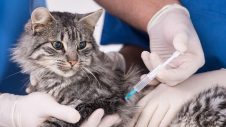 Infections of the external ear canal (outer ear) by bacteria or yeast, is one of the most common types of infections seen in dogs and cats. It is called otitis externa. Some breeds, particularly those with large ear flaps or hairy ears like Cocker Spaniels, Miniature Poodles or Golden Retrievers, seem more prone to ear infections, but they can occur in any breed.
Infections of the external ear canal (outer ear) by bacteria or yeast, is one of the most common types of infections seen in dogs and cats. It is called otitis externa. Some breeds, particularly those with large ear flaps or hairy ears like Cocker Spaniels, Miniature Poodles or Golden Retrievers, seem more prone to ear infections, but they can occur in any breed.
Dogs and cats ear canals are long “L” shaped, funnel-like tubes that are great for hearing but this shape predisposes to collection of debris and moisture.
What are the symptoms of an ear infection?
A pet with an ear infection is uncomfortable and their ear canals will be sensitive. A pet may shake its head or scratch at its ears, which leads to the ears becoming red and inflamed. They will often develop an odour and visually, a black or yellowish discharge can be seen. These are all common symptoms that your pet could be living with an ear problem.
What can cause an ear infection?
Ear mites can be a cause of an ear infection, but this occurs most commonly in younger pets. There are several types of infectious bacteria, yeast, and fungus which might cause an ear infection. Without knowing the kind of infection present it is difficult to treat effectively. In some cases, a foreign body or growth in the ear canal may cause the ear to become irritated. Treatment with medication alone will not resolve these problems. It is essential to have your pet’s eardrums examined to ensure they are intact. This is necessary because certain medications can result in loss of hearing if the eardrum is ruptured. The diagnosis is made by your veterinarian.
Diagnosis
Having your pet’s ear examined will allow your veterinarian to determine whether the eardrum is intact and if there are any foreign materials in the canal. When a pet is in extreme pain and refuses to allow the examination, it may be necessary to sedate or anaesthetise the pet for a thorough examination.
How are ear infections treated?
If there is foreign matter or excess discharge in the ear canal, the pet may need to be sedated or anaesthetised so that it can be removed. This discharge will prevent any eardrops penetrating the full length of the canal and thus stopping the healing process. Cytological study of debris from the ear canal dictates which treatment method or medication to use. Sometimes, it reveals the presence of more than one type of infection and this may require the use of multiple medications.
The treatment of ear infections must be continued for as long as your veterinarian has advised to minimise the chance of an ear infection reoccurring.
Aftercare at home
- follow the medication directions that have been advised by your veterinarian
- avoid the ears getting wet – no swimming and only wash the head with a damp cloth
How to prevent ear infections
Cleaning your pet’s ears periodically with pet ear wipes will give you a chance to examine your pet’s ears for signs of any problems.
Remember to watch for signs like tenderness, discharge, redness or odour from your pet’s ears. If these signs develop, contact your local Greencross Vets.

 Greencross Vets
Greencross Vets 











